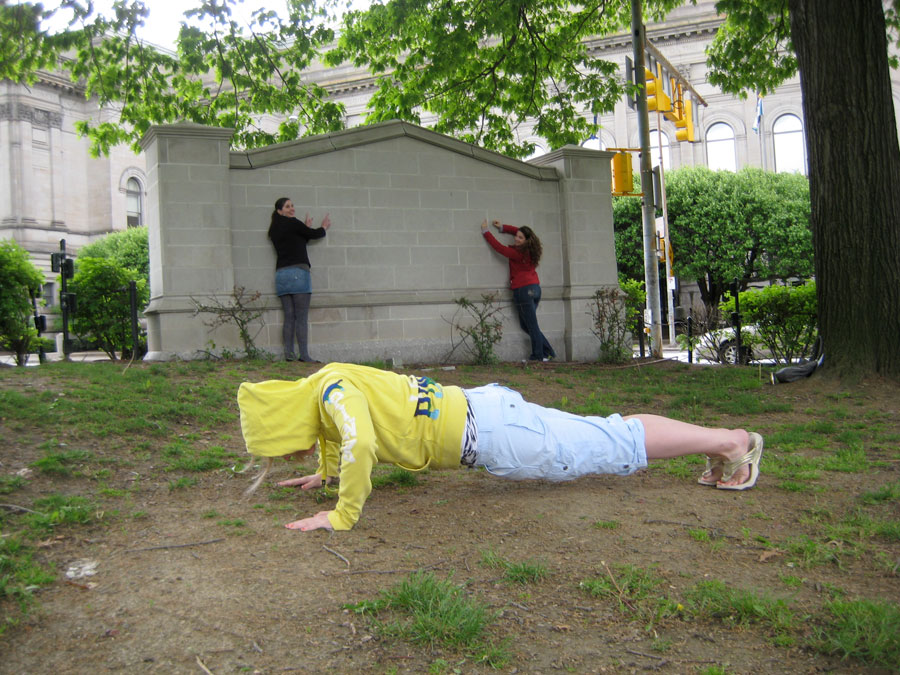 BID.2010 - Assignment 4
BID.2010 - Assignment 4 Research Research |
 Process Process |
 Design Design |
 Video Sketch Video Sketch |
Quad Challenge
Design Process
Overview
After our initial research effort, we generated 36 concepts, each connecting 1 or more of our unifying themes with the charge of the assignment. From this preliminary list, we selected 20 ideas to sketch out and present for feedback. After this review, we selected 5 ideas to storyboard and take back into the field for in-context needs validation. This process revealed 1 idea, the Quad Challenge, as the best idea to fully develop for a video sketch.
01 Ideation
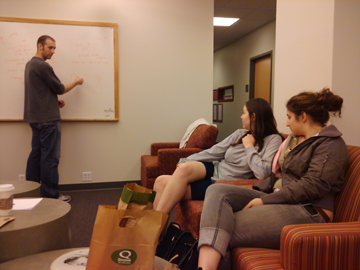
After our research, we held an ideation session that yielded 36 initial ideas to connect our unifying theme with the charge of the assignement. These ideas covered a wide range of topics including encouraging people to recycle, motivating physical activity, helping people move across Forbes Street Bridge, and informing people of the truth. We pared these down to a set of 20 to develop further through sketches that we presented to the class to solicit feedback.
02 Speed Dating
After presenting 20 ideas to the class, each classmate voted for their 5 favorites using post-its that they could optionally provide feedback on. A handful of the concepts recieved the majority of the votes. We also recieved the feedback that several of the ideas were so similar that they should be combined.
Using their feedback, we were able to select 5 ideas further develop and validate through speed dating. For each idea, we selected a location for implementation, developed a storyboard, and went into the field to perform needs validation. Below we describe the interaction of each of these 5 concepts, the users that were targeted, the needs they intended to meet, and the results of our concept validation through speed dating. The results of the speed dating process overwhelmingly favored 1 idea, the Quad Challenge.
Fact Check
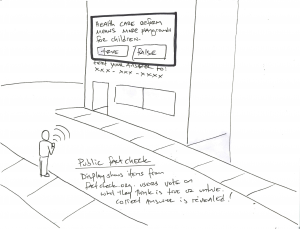
Interaction: A display at the 5th & Craig bus stop shows a statement made recently by a politician, news anchor, or other prominent influential figure, and asks the question, "True or False?" After people vote, the display reveals the correct answer and and a brief explanation.
Audience: Our display is meant for people waiting for the bus lines that stop at 5th and Craig. We specifically want to challenge those users who have strong partisan opinions, and make them question where their information comes from.
Needs: Our display satisfies a social need by helping keep individuals calibrated and able to filter information and identify which information may be true. Our interaction prompts the user to pause and think about what he assumes as truth.
Concept Validation:

We presented a storyboard to participants at the bus stop at 5th and Craig. People were uninterested and didn't understand how what we were doing applied to them. One participant brought up issues of trust. "It's just a sign at a bus stop. I would have to research it myself." Although this satisfies our goals of raising awareness and promoting critcal thinking, the concept was generally regarded with skepticism. We came away with some ideas for improvent, but decided this was not the idea to move forward with.
Quad Challenge
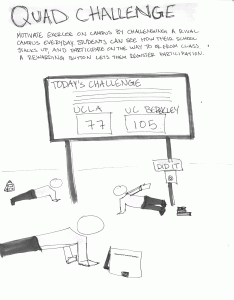
Interaction: Quad Challenges proposes a competition between two college rivals, namely University of Pittsburgh and West Virginia University. A scoreboard tracks progress at the two sites. Sensors log the participation of anyone who performs the sanctioned activity.
Audience: This concept is for college students. The motivation for participation comes from a sense of belonging to the targeted community and a rivalry between opposing sites. For this reason, the college affiliation seems ideal.
Research: We observed university students in Schenley Plaza. We did not find a lot about their exercise habits, but we did pick up on where they sit and why.
Needs: Our display satisfies a social need to build community. It also satisfies a physical need by getting people exercising when they typically would not.
Concept Validation:
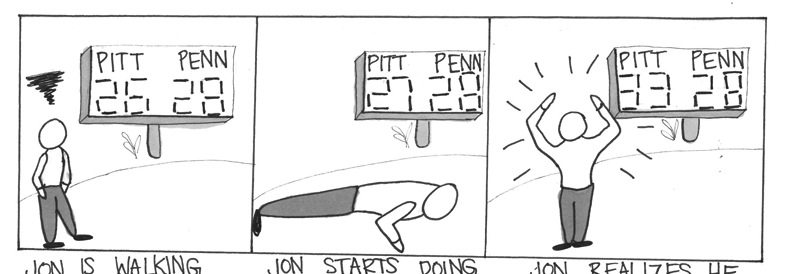
We presented a storyboard to participants in the courtyard at the Cathedral of Learning. In response to the prompt, "How would you respond if you saw your team was losing?" We got a resounding response of, "I would do pushups." One girl who was skeptical at first, eventually came around after discussing the idea further. Most participants were very motivated by university spirit, inter-collegiate challenge, and personal pride. 75% of participants said they would take part in the Quad Challenge. This reception made this concept the clear choice to move forward with.
Forbes Street Bridge
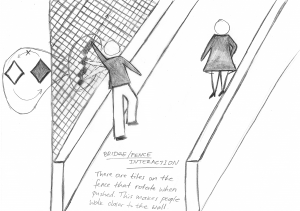
Interaction: This sketch represents our initial idea to provide a tactile interaction with the fence on the bridge located on Forbes Street near the CMU campus. There is heavy traffic throughout most of the day but especially in the passing times between classes. The most frequent users of the space are CMU students, faculty, and staff, but other passers-by also use the bridge. The interactive element is the surface of the fence, which changes upon touch. People can choose whether they want to engage in the interaction or not. An alternative interaction technique that we discussed entailed the use of directed sound to encourage a faster pace and discourage lingering.
Audience: The intended audience is the pedestrian traffic along Forbes Street Bridge. This mostly consists of Carnegie Mellon students, faculty, and staff; however, people who live and/or work in the vicinity are also likely to be regular users of the bridge.
Needs: The bridge is very narrow, resulting in poor traffic flow, and difficulty passing a person in front of you. Our goal is to activate the environment in a way that promotes quicker and easier navigation of the bridge. In doing so, we are addressing functional needs of the user.
Concept Validation:


We prepared and tested two storyboards for this concept, one for each style of interaction. We were surprised at the luke-warm reaction of our participants. Only 50% recognized the congestion as a problem, and none were convinced of our solution.
Speech Poetry/Community Story
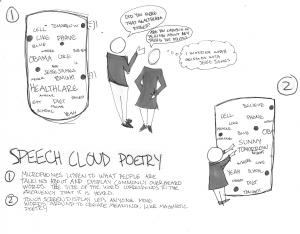
Interaction: A large multi-touch display in Schenley Plaza is outfitted with microphones that listen-in on the conversations of passers-by. A speech recognition engine parses conversation data and the system determines common words to display. On the interactive display, words are displayed in tag-cloud style, size being determined by the word's frequency in overheard conversations. Users can interact with the multitouch display by moving words around, arranging them to create some higher order meaning.
Audience: This surface could be used by the lunch crowd at Schenley Plaza. People mostly come in pairs and groups, and so conversation is a large component of the Schenley Plaza experience.
Needs: Although this concept doesn't fill any particular "need" it does satisfy a curiosity. The aggregate data on the display shows the minds of people in the area. Any higher-level meaning that is achieved through the interactive piece also exhibits the consciousness of the people around.
Concept Validation:
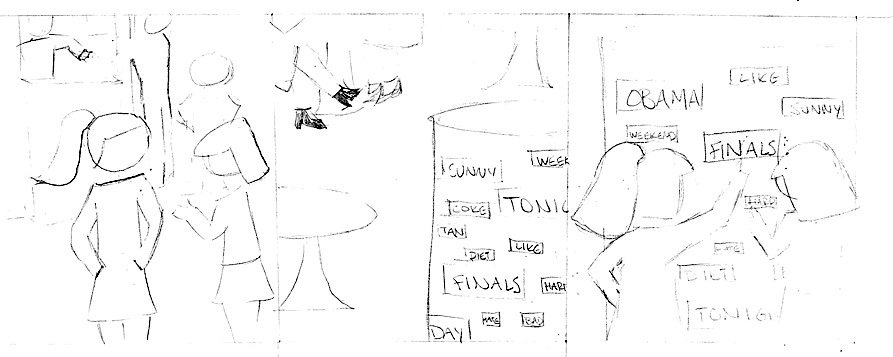
We presented this storyboard to lunchers at Schenley Plaza on a sunny afternoon. People did not like the fact that there were microphones listening to their conversation without them knowing. They also said they would be inclined to censor themselves or say random things if they knew they were being recorded. There were questions about the legality of recording people in a public space. About 50% of participants said they might check out an interactive display if they passed by it, but no one was very excited about the concept as a whole.
Anachronistic Photo Time Capsule
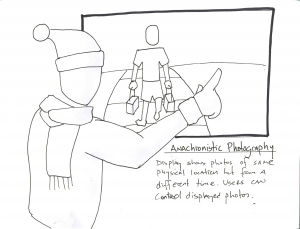
Interaction: A large public display over the intersection at Forbes and Murray shows a photo taken from the current location but from a previous time. The time-stamp on the photo will be linked to the identity of people passing in hopes that someone nearby will have physically been at the location when the photo was taken. Viewing this photo causes passers-by to consider the ever changing nature of the current location and through this experience, all locations. The sensor 'catches' the cell phone signal from each individual as a means for identification.
Audience: Our display is meant to reach all people walking through the space. As the method for reflection is related to reflection upon weather and time, all users who experience the display will have some level of context and understanding.
Needs: Our display breaks the person experiencing it out of their everyday routine and reminds them that, while their current situation may be pleasant or unpleasant, things change. Situational recalibration is an experience that is needed by all.
Concept Validation: 66% of participants were completely uninterested in the idea. One person was initially uninterested but was eventually very enthusiastic about the potential to see the space over a 50 year increment. Another participant was interested in the idea if there was something interesting going on in the photo, like a parade, but not in the capture of the mundane everyday activity of the intersection.
03 Selection
Quad Challenge
Through this lengthy process, we selected the Quad Challenge as our final idea to fully develop and design. We developed characters and scenarios, and created a video sketch to explore the idea. Our final designs can be found in the following section.
